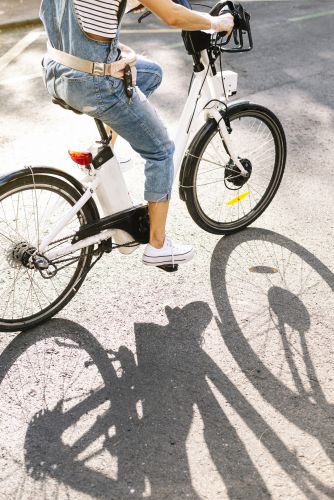TUCSON, Arizona (BRAIN) — As PeopleForBikes' Electric Bicycle Summit—a one-day affair—got underway late last week, a key takeaway was this: The industry is struggling to understand the impact of a fast-growing e-bike boom.
Whether it's unit sales, average selling price, inventory, supply chain snafus, rider usage, safety training, reporting e-bike injuries and deaths, supplier and seller liability, battery recycling, new trends in advocacy or the impact of internet sales, the industry lacks accurate baselines to measure the future potential of the e-bike industry.
There is no disagreement among attendees at the all-day conference held at a hotel near the University of Arizona campus that e-bikes are in the midst of shifting the industry away from its traditional focus on so-called "acoustic" bikes to a booming—at least for now—market for e-bikes. Still, traditional bike sales far outstrip e-bike sales, at least for the moment.
Larry Pizzi, chief commercial officer for Alta Cycling Group and a PeopleForBikes board member, opened the session noting that "it's amazing what's been accomplished with e-bikes in the last ten years."
The pandemic, he noted, added a tailwind to growth in e-bike sales and, as a result, the industry has come to understand there are significant concerns over safety, rider etiquette and other issues. "We hadn't anticipated that, but with growth we need to expand our definition of what an e-bike is and what it can become," he said.
A session on safety issues highlighted problems the industry could face in the future. The discussion zeroed in on kids who appear to be adopting e-bikes at a rate not seen in decades. Yet they are often ill-prepared to handle a bike with power and lack the basic knowledge of how to ride a bike safely, whether e-bikes or acoustic bikes.
Don DiCostanzo, Pedego's chief executive officer, offered an impassioned plea for the industry to get behind rider training for kids and adults. And, he added, perhaps there should be an age limit on e-bike sales. It appears many parents are buying e-bikes online for their children without thinking through the consequences.
Pedego, for example, is seeing a surge of adult purchasers who come into a store who haven't ridden a bike since they were kids. "They need some training and guidance," DiCostanzo said, adding that Pedego will soon implement e-bike rider training as part of the sale.
Another wrinkle that emerged at the conference was how e-bike accidents are reported. Researchers at the University of Tennessee and the other from Portland State University, are in the midst of a variety of projects attempting to learn more about rider usage, revamping accident codes to better delineate e-bike accidents, and how e-bikes impact other transportation systems.
Ironically, Dr. Christopher Cherry, a professor at the University of Tennessee's College of Engineering, told attendees that e-bike accidents — whether injuries or fatalities — are currently classified in emergency rooms as motorcycle accidents. That bit of news took attendees by surprise.
But it's kids riding e-bikes with little or no training on what is essentially a battery-driven product that should concern the industry most.
Some participants expressed concern that if the industry fails to step up, cities, regions and states will take legislative action that could have adverse effects on the industry. (PFB is about to roll-out a video as part of an industry led safety campaign for municipalities, dealers and advocates.)
At the moment, though, the lack of statistics on overall sales and where they occur leaves the industry unable to accurately forecast future growth and trends. But to be fair, the specialty bicycle industry has long had difficulties agreeing on the accuracy of data reporting agencies have compiled.
For example, there seems to be a general consensus that e-bike sales through all channels in 2021 will be in the one million unit range — plus or minus a few hundred thousand.
Jennifer Boldry, PFB's chief research analyst, said the industry's lack of overall data on e-bike sales, especially through non-traditional channels, is daunting.
"We don't currently have a line of sight into sales by eIBDs, direct-to-consumer, third-party e-commerce (think Amazon) and used bike sales," she said. "We're not capturing any of this data," Boldry added.
Out of that one million unit number, Boldry estimates about 300,000 units were sold through traditional channels, but NPD's data is capturing only 2% of sales through its reporting retailers. The result, she said, was an ongoing underestimation of the market's size and rate of growth.
To make her point, Boldry put up a slide from Costco advertising a $399 folding e-bike. At that price it becomes almost an impulse purchase.
Echoing the general concern over a lack of reliable data, particularly ridership, was John MacArthur, a researcher at Portland State University, "We just don't know very much," he said.
For example, no one knows the number of e-bike riders. "The numbers we have are not very accurate," MacArthur said. Complicating that is a lack of knowledge on how riders use e-bikes whether for recreation, transportation, or simply going to the grocery store.
But one finding MacArthur cited from a recent study was that the pandemic seems to have had little impact on recreational riders. But, on the other hand, the utilitarian use of e-bikes seems to have declined as well as bike-share usage.
Still, as the pandemic waxes and wanes it appears bike-share usage is moving back to pre-pandemic levels.
Claudia Wasko, general manager of Bosch eBike Systems in the U.S., pointed out that countries within the European Union have developed an array of data on e-bike usage. "We really need more data in the U.S.," she said.


